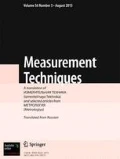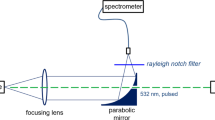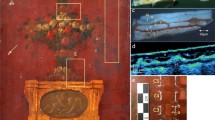A method of monitoring the process of laser cleaning of monuments and other works of art in the course of conservation is presented. The capabilities of the method of laser-induced breakdown plasma spectroscopy in cleaning of monuments made of metal are considered. A photometric device based on an integrating cavity in the form of a cylinder is developed and investigated. The capabilities gained with the use of the device for proximate analysis of the efficiency of the process of cleaning the surfaces of sculpture made of marble and limestone structures are shown.



Similar content being viewed by others
References
M. Cooper, Laser Cleaning in Conservation: An Introduction, Butterworth–Heinemann, Oxford (1998).
C. Fotakis, D. Anglos, V. Zafiropoulos, et al., Lasers in the Preservation of Cultural Heritage. Principles and Applications, CRC Press, Taylor & Francis Group, Boca Raton (USA) (2007).
V. A. Parfenov, Laser Cleaning of Historical and Cultural Monuments, Izd. SPbGETU LETI, St. Petersburg (2015).
V. Verges-Belmin and C. Dignard, “Laser yellowing: myth or reality,” J. Cultur. Herit., 4, 238–244 (2003).
V. A. Parfenov and I. A. Yudin, “Atomic-force microscopy and its use in science, engineering, and conservation,” Izv. SPbGETU LETI, No. 9, 61–70 (2015).
M. Gora, A. Rycyk, J. Marczak, et al., “From medical to art diagnostics. OCT: a novel tool for varnish ablation control,” SPIE Proc., 6429, 64292V-1 (2007).
I. A. Grigor’eva, V. A. Parfenov, D. S. Prokuratov, and A. L. Shakhmin, “Laser cleaning of copper in air and nitrogen media,” Opt. Zh., 84, No. 1, 3–8 (2017).
V. A. Parfenov, J. Asmus, M. Magde, et al., “Underwater inverse LIBS (iLIBS) for marine archeology,” SPIE Proc., 8790, 8790V-1–8790V-12 (2013).
M. M. Gurevich, Photometry. Theory, Methods, and Devices, Energoatomizdat, Leningrad (1983).
S. Siano, F. Fabiano, R. Pini, et al., “Determination of damage threshold to prevent side effects in laser cleaning of Pliocene sandstone of Siena,” J. Cultur. Herit., 1, No. 1, S47–S53 (2000).
The present investigations were performed with the support of the Ministry of Education and Science (State Contract No. 14.740.11.0601 for R&D “Development of Laser Technologies in Conservation of Works of Art”).
Author information
Authors and Affiliations
Corresponding author
Additional information
Translated from Izmeritel’naya Tekhnika, No. 4, pp. 25–29, April, 2018.
Rights and permissions
About this article
Cite this article
Parfenov, V.A. Methods and Devices for Monitoring the Process of Laser Cleaning of Artworks. Meas Tech 61, 353–359 (2018). https://doi.org/10.1007/s11018-018-1433-2
Received:
Published:
Issue Date:
DOI: https://doi.org/10.1007/s11018-018-1433-2




